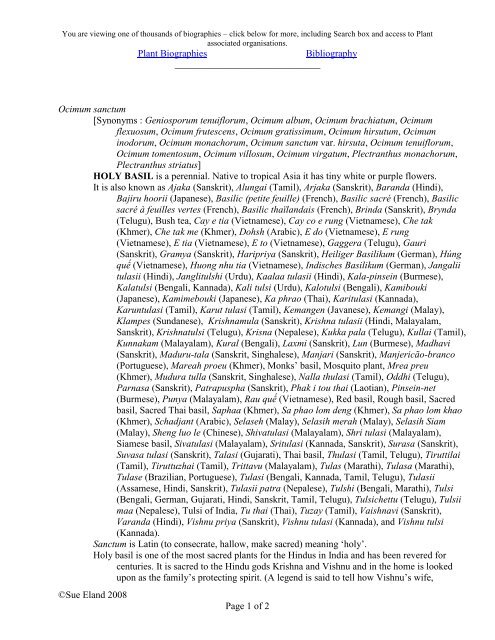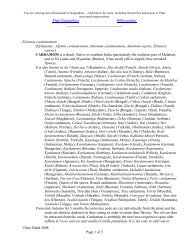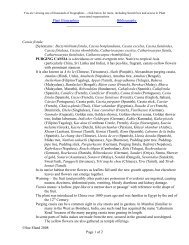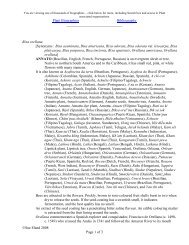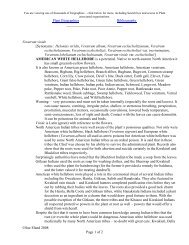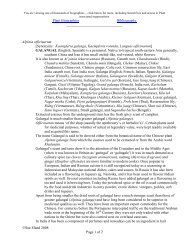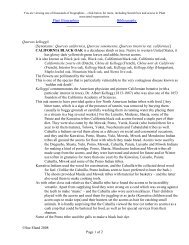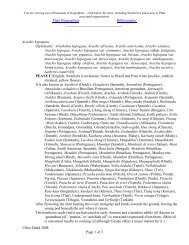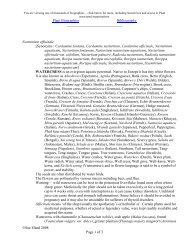Holy basil - Plant Biographies
Holy basil - Plant Biographies
Holy basil - Plant Biographies
You also want an ePaper? Increase the reach of your titles
YUMPU automatically turns print PDFs into web optimized ePapers that Google loves.
You are viewing one of thousands of biographies – click below for more, including Search box and access to <strong>Plant</strong><br />
associated organisations.<br />
<strong>Plant</strong> <strong>Biographies</strong><br />
Bibliography<br />
______________________________<br />
Ocimum sanctum<br />
[Synonyms : Geniosporum tenuiflorum, Ocimum album, Ocimum brachiatum, Ocimum<br />
flexuosum, Ocimum frutescens, Ocimum gratissimum, Ocimum hirsutum, Ocimum<br />
inodorum, Ocimum monachorum, Ocimum sanctum var. hirsuta, Ocimum tenuiflorum,<br />
Ocimum tomentosum, Ocimum villosum, Ocimum virgatum, Plectranthus monachorum,<br />
Plectranthus striatus]<br />
HOLY BASIL is a perennial. Native to tropical Asia it has tiny white or purple flowers.<br />
It is also known as Ajaka (Sanskrit), Alungai (Tamil), Arjaka (Sanskrit), Baranda (Hindi),<br />
Bajiru hoorii (Japanese), Basilic (petite feuille) (French), Basilic sacré (French), Basilic<br />
sacré à feuilles vertes (French), Basilic thaïlandais (French), Brinda (Sanskrit), Brynda<br />
(Telugu), Bush tea, Cay e tia (Vietnamese), Cay co e rung (Vietnamese), Che tak<br />
(Khmer), Che tak me (Khmer), Dohsh (Arabic), E do (Vietnamese), E rung<br />
(Vietnamese), E tia (Vietnamese), E to (Vietnamese), Gaggera (Telugu), Gauri<br />
(Sanskrit), Gramya (Sanskrit), Haripriya (Sanskrit), Heiliger Basilikum (German), Húng<br />
quế (Vietnamese), Huong nhu tia (Vietnamese), Indisches Basilikum (German), Jangalii<br />
tulasii (Hindi), Janglitulshi (Urdu), Kaalaa tulasii (Hindi), Kala-pinsein (Burmese),<br />
Kalatulsi (Bengali, Kannada), Kali tulsi (Urdu), Kalotulsi (Bengali), Kamibouki<br />
(Japanese), Kamimebouki (Japanese), Ka phrao (Thai), Karitulasi (Kannada),<br />
Karuntulasi (Tamil), Karut tulasi (Tamil), Kemangen (Javanese), Kemangi (Malay),<br />
Klampes (Sundanese), Krishnamula (Sanskrit), Krishna tulasii (Hindi, Malayalam,<br />
Sanskrit), Krishnatulsi (Telugu), Krisna (Nepalese), Kukka pala (Telugu), Kullai (Tamil),<br />
Kunnakam (Malayalam), Kural (Bengali), Laxmi (Sanskrit), Lun (Burmese), Madhavi<br />
(Sanskrit), Maduru-tala (Sanskrit, Singhalese), Manjari (Sanskrit), Manjericão-branco<br />
(Portuguese), Mareah proeu (Khmer), Monks’ <strong>basil</strong>, Mosquito plant, Mrea preu<br />
(Khmer), Mudura tulla (Sanskrit, Singhalese), Nalla thulasi (Tamil), Oddhi (Telugu),<br />
Parnasa (Sanskrit), Patrapuspha (Sanskrit), Phak i tou thai (Laotian), Pinsein-net<br />
(Burmese), Punya (Malayalam), Rau quế (Vietnamese), Red <strong>basil</strong>, Rough <strong>basil</strong>, Sacred<br />
<strong>basil</strong>, Sacred Thai <strong>basil</strong>, Saphaa (Khmer), Sa phao lom deng (Khmer), Sa phao lom khao<br />
(Khmer), Schadjant (Arabic), Selaseh (Malay), Selasih merah (Malay), Selasih Siam<br />
(Malay), Sheng luo le (Chinese), Shivatulasi (Malayalam), Shri tulasi (Malayalam),<br />
Siamese <strong>basil</strong>, Sivatulasi (Malayalam), Sritulasi (Kannada, Sanskrit), Surasa (Sanskrit),<br />
Suvasa tulasi (Sanskrit), Talasi (Gujarati), Thai <strong>basil</strong>, Thulasi (Tamil, Telugu), Tiruttilai<br />
(Tamil), Tiruttuzhai (Tamil), Trittavu (Malayalam), Tulas (Marathi), Tulasa (Marathi),<br />
Tulase (Brazilian, Portuguese), Tulasi (Bengali, Kannada, Tamil, Telugu), Tulasii<br />
(Assamese, Hindi, Sanskrit), Tulasii patra (Nepalese), Tulshi (Bengali, Marathi), Tulsi<br />
(Bengali, German, Gujarati, Hindi, Sanskrit, Tamil, Telugu), Tulsichettu (Telugu), Tulsii<br />
maa (Nepalese), Tulsi of India, Tu thai (Thai), Tuzay (Tamil), Vaishnavi (Sanskrit),<br />
Varanda (Hindi), Vishnu priya (Sanskrit), Vishnu tulasi (Kannada), and Vishnu tulsi<br />
(Kannada).<br />
Sanctum is Latin (to consecrate, hallow, make sacred) meaning ‘holy’.<br />
<strong>Holy</strong> <strong>basil</strong> is one of the most sacred plants for the Hindus in India and has been revered for<br />
centuries. It is sacred to the Hindu gods Krishna and Vishnu and in the home is looked<br />
upon as the family’s protecting spirit. (A legend is said to tell how Vishnu’s wife,<br />
©Sue Eland 2008<br />
Page 1 of 2
Lakhsmi, assumed the form of holy <strong>basil</strong> so that she could soothe the world.) <strong>Holy</strong> <strong>basil</strong><br />
can be found growing near most Hindu homes usually on pedestals in the courtyard. The<br />
addition of a few leaves to a Hindu dish not only adds flavour but also consecrates it at<br />
the same time – although it is understood that many Hindus avoid using any form of <strong>basil</strong><br />
in cooking, not just this species. During funerals <strong>basil</strong> is still placed on the breast of the<br />
body of the Hindu who has died.<br />
Like <strong>basil</strong> (Ocimum <strong>basil</strong>icum), holy <strong>basil</strong> has also been cultivated on the Indonesian island of<br />
Sumatra for ritual offerings to the spirits.<br />
This species can be added (sparingly) to salads and used as a condiment. In Asia it is often<br />
chewed as an alternative to betel (Piper betle).<br />
Old thick stems are used to make beads.<br />
Medicinally, a decoction of the plant has been prescribed in Asian countries for treating<br />
coughs, bronchitis, children’s gastric disorders and various skin diseases.<br />
©Sue Eland 2008<br />
Page 2 of 2


